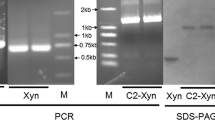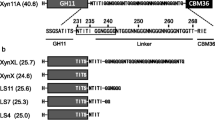Abstract
A non-cellulosomal xylanase from Clostridium thermocellum, XynX, consists of a family-22 carbohydratebinding module (CBM22), a family-10 glycoside hydrolase (GH10) catalytic module, two family-9 carbohydrate-binding modules (CBM9-I and CBM9-II), and an S-layer homology (SLH) module. E. coli BL21(DE3) (pKM29), a transformant carrying xynX′, produced several truncated forms of the enzyme. Among them, three major active species were purified by SDS-PAGE, activity staining, gel-slicing, and diffusion from the gel. The truncated xylanases were different from each other only in their C-terminal regions. In addition to the CBM22 and GH10 catalytic modules, XynX1 had the CBM9-I and most of the CBM9-II, XynX2 had the CBM9-I and about 40% of the CBM9-II, and XynX3 had about 75% of the CBM9-I. The truncated xylanases showed higher binding capacities toward Avicel than those toward insoluble xylan. XynX1 showed a higher affinity toward Avicel (70.5%) than XynX2 (46.0%) and XynX3 (42.1%); however, there were no significant differences in the affinities toward insoluble xylan. It is suggested that the CBM9 repeat, especially CBM9-II, of XynX plays a role in xylan degradation in nature by strengthening cellulose binding rather than by enhancing xylan binding.
Similar content being viewed by others
References
Bayer, E.A., J-P. Belaich, Y. Shoham, and R. Lamed. 2004. The cellulosomes: multienzyme machines for degradation of plant cell wall polysaccharides. Annu. Rev. Microbiol. 58, 521–554.
Bayer, E.A., R. Lamed, B.A. White, and H.J. Flint. 2008. From cellulosomes to cellulosomics. Chem. Rec. 8, 364–377.
Bayer, E.A., Y. Shoham, and R. Lamed. 2006. Cellulose-decomposing bacteria and their enzyme systems. Prokaryotes 2, 578–617.
Beguin, P. and M. Lemaire. 1996. The cellulosome: an exocellular, multiprotein complex specialized in cellulose degradation. Crit. Rev. Biochem. Mol. Biol. 31, 201–236.
Boraston, A.B., A.L. Creagh, M.M. Alam, J.M. Kormos, P. Tomme, C.A. Haynes, R.A.J. Warren, and D.G. Kilburn. 2001. Binding specificity and thermodynamics of a family 9 carbohydrate-binding module from Thermotoga maritima xylanase 10A. Biochemistry 40, 6240–6247.
Charnock, S.J., D.N. Bolam, J.P. Turkenburg, H.J. Gilbert, L.M.A. Ferreira, G.J. Davis, and C.M.G.A. Fontes. 2000. The X6 “thermostabilizing” domains of xylanases are carbohydratebinding modules: structure and biochemistry of the Clostridium thermocellum X6b domain. Biochemistry 39, 5013–5021.
Demain, A.L., M. Newcomb, and J.H. Wu. 2005. Cellulase, clostridia, and ethanol. Microbiol. Mol. Biol. Rev. 69, 124–154.
Dias, F.M.V., A. Goyal, H.J. Gilbert, J.A.M. Prates, L.M.A. Ferreira, and C.M.G.A. Fontes. 2004. The N-terminal family 22 carbohydratebinding module of xylanase 10B of Clostridium themocellum is not a thermostabilizing domain. FEMS Microbiol. Lett. 238, 71–78.
Fernandes, A.C., C.M.G.A. Fontes, H.J. Gilbert, G.P. Hazelwood, T.H. Fernandes, and L.M.A. Ferreira. 1999. Homologous xylanases from Clostridium thermocellum: evidence for bi-functional activity, synergism between xylanase modules and the presence of xylanbinding domains in the enzyme complexes. Biochem. J. 342, 105–110.
Fontes, C.M.G.A., G.P. Hazlewood, E. Morag, J. Hall, B.H. Hirst, and H.J. Gilbert. 1995. Evidence for a general role for non-catalytic thermostabilizing domains in xylanases from thermophilic bacteria. Biochem. J. 307, 151–158.
Gold, N.D. and V.J.J. Martin. 2007. Global view of the clostridium thermocellum cellulosome revealed by quantitative proteomic analysis. J. Bacteriol. 189, 6786–6795.
Grepinet, O., M.C. Chebrou, and P. Beguin. 1988. Nucleotide sequence and deletion analysis of the xylanase gene (xynZ) of Clostridium thermocellum. J. Bacteriol. 170, 4582–4588.
Hall, J. and H.J. Gilbert. 1988. The nucleotide sequence of a carboxymethyl-cellulase gene from Pseudomonas fluorescens subsp. cellulosa. Mol. Gen. Genet. 213, 112–117.
Hayashi, H., K.I. Takagi, M. Fukumura, T. Kimura, S. Karita, K. Sakka, and K. Ohmiya. 1997. Sequence of Xyn C and properties of XynC, a major component of the Clostridium thermocellum cellulosome. J. Bacteriol. 179, 4246–4253.
Hayashi, H., M. Takehara, T. Hattori, T. Kimura, S. Karita, K. Sakka, and K. Ohmiya. 1999. Nucleotide sequences of two contiguous and highly homologous xylanase genes XynA and XynB and characterization of XynA from Clostridium thermocellum. Appl. Microbiol. Biotechnol. 51, 348–357.
Jung, K.H., K.M. Lee, H. Kim, K.H. Yoon, S.H. Park, and M.Y. Pack. 1998. Cloning and expression of a Clostridium thermocellum xylanase gene in Escherichia coli. Biochem. Mol. Biol. Int. 44, 283–292.
Kim, H., K.H. Jung, and M.Y. Pack. 2000. Molecular characterization of xynX, a gene encoding a multidomain xylanase with a thermostabilizing domain from Clostridium thermocellum. Appl. Microbiol. Biotechnol. 54, 521–527.
Kim, H., S.F. Kim, D.H. Ahn, J.H. Lee, and M.Y. Pack. 1995. Internal cleavage of Bacillus subtilis BSE616 endo-β-1,4-glucanase expressed in Escherichia coli. J. Microbiol. Biotechnol. 5, 26–30.
Kim, H., S.F. Kim, and M.Y. Pack. 1991. C-Terminal processing of Bacillus subtilis BSE 616 endo-β-1,4-glucanase in Bacillus megaterium. Biotechnol. Lett. 13, 799–804.
Lowry, O.H., N.J. Rosenbrough, A.L. Farr, and R.L. Randell. 1951. Protein measurement with the Folin phenol reagent. J. Biol. Chem. 193, 265–275.
Marchler-Bauer, A., J.B. Anderson, F. Chitsaz, M.K. Derbyshire, C. DeWeese-Scott, J.H. Fong, L.Y. Geer, and et al. 2009. CDD: specific functional annotation with the Conserved Domain Database. Nucleic Acids. Res. 37(Database issue), 205–210.
Meissner, K., D. Wassenberg, and W. Liebl. 2000. The thermostabilizing domain of the modular xylanase XynA of Thermotoga maritima represents a novel type of binding domain with affinity for soluble xylan and mixed-linkage β-1,3/β-1,4-glucan. Mol. Microbiol. 36, 898–912.
Sunna, A., M.D. Gibbs, and P.L. Bergquist. 2000. The thermostabilizing domain, XynA, of Caldibacillus cellulovorans xylanase is a xylan binding domain. Biochem. J. 346, 583–586.
Shin, E.S., M.J. Yang, K.H. Jung, E.J. Kwon, J.S. Jung, S.K. Park, J. Kim, H.D. Yun, and H. Kim. 2002. Influence of the transposition of the thermostabilizing domain of Clostridium thermocellum xylanase (XynX) on xylan binding and thermostabilization. Appl. Environ. Microbiol. 68, 3496–3501.
Zhao, G., E. Ali, R. Araki, M. Sakka, T. Kimura, and K. Sakka. 2005. Function of the family-9 and family-22 carbohydrate-binding modules in a modular β-1,3-1,4-glucanase/xylanase derived from Clostridium stercorarium Xyn10B. Biosci. Biotechnol. Biochem. 69, 1562–1567.
Zverlov, V.V., N. Schantz, P. Schmitt-Kpplin, and W.H. Schwarz. 2005. Two new major subunits in the cellulosome of Clostridium thermocellum: xyloglucanase Xgh74A and endoxylanase Xyn10D. Microbiology 151, 3395–3401.
Author information
Authors and Affiliations
Corresponding author
Rights and permissions
About this article
Cite this article
Selvaraj, T., Kim, S.K., Kim, Y.H. et al. The role of carbohydrate-binding module (CBM) repeat of a multimodular xylanase (XynX) from Clostridium thermocellum in cellulose and xylan binding. J Microbiol. 48, 856–861 (2010). https://doi.org/10.1007/s12275-010-0285-5
Received:
Accepted:
Published:
Issue Date:
DOI: https://doi.org/10.1007/s12275-010-0285-5




